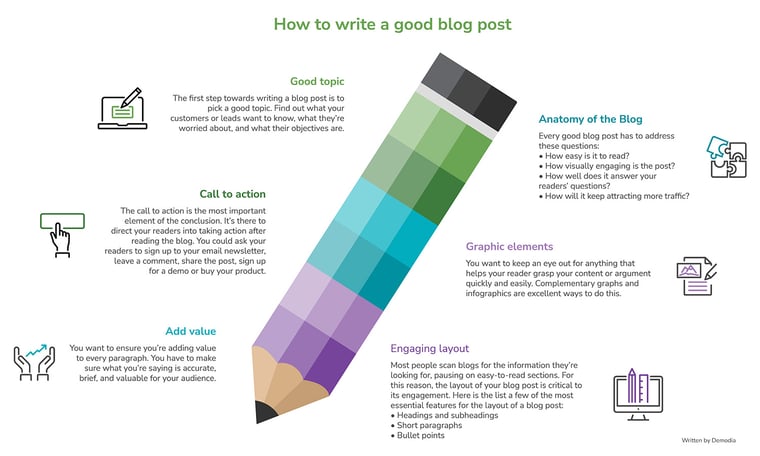
Blog posts are the baseline of a great content marketing strategy
If you want to bring customers to you, a great content marketing campaign should be your first objective - but where do you start? One of the best ways to set a solid base for content marketing is a regularly updated blog. However, so many digital marketers find it challenging to come up with interesting topics or even put them together, ending their content marketing dreams before they begin.
We understand the challenge of generating new ideas every week, which is why we’re here to help. In this blog post, we’ll reveal our secrets to writing a good blog post so you can start bringing your customers to you.
The anatomy of a blog post
Every good blog post has to address these questions:
- How easy is it to read?
- How visually engaging is the post?
- How well does it answer your readers’ questions?
- How will it keep attracting more traffic?
Before we get into the details of what makes a good blog post, we need to take a step back and see the big picture. You may think that a blog is all about the words that it consists of - but this is far from the truth.
Instead, a blog is made up of three distinct parts:
- The copy
- The design
- The layout
Let’s take a closer look at each.
The copy
The blog post’s text itself is the meat of a good post, but it needs both design and layout to make it truly stand out. Throughout the copy, you should be addressing the topic of your blog post in a relevant, interesting and concise way.
Here are a few things to consider for the copy of your blog post.
The title
The first step towards writing a blog post is to pick a good topic. Find out what your customers or leads want to know, what they’re worried about, and what their objectives are. If you need a place to start, you can use SEO tools to find trending topics, but it’s always better to understand your typical customer on a fundamental level.
Once you have your topic, your title should position itself as answering your customer’s questions or providing valuable useful information. A good way to do this is to include the question itself in your title or speak directly to your customers’ fear, challenge, or aspiration.
The introduction
Your introduction should cover what your blog will be exploring and the primary problem it will resolve for your customers. Ideally, you want to address this within the first two sentences of the introduction. An excellent way to achieve this is to pose a question addressing the reader’s problem and immediately tell them how they can resolve it, grabbing their attention early.
The body
As the largest piece of text, you want to ensure you’re adding value to every paragraph. The only way to do that is through research. You don’t have to be an expert, but you have to make sure what you’re saying is accurate, brief, and valuable for your audience. For this reason, try to write short sentences with easier to read and understand words.
Style and tone will come to the forefront when writing the body of your text. Simply writing how you talk can be an easy way to present your own writing style. This is a great way to make your readers feel like they’re having a conversation with someone, rather than reading a post online.
The conclusion
The final paragraph of your blog post should always do two things:
- Summarise the post
- Include a call to action
Summarising what your blog explored should revisit the customer’s main problem or question, present the solution, and the reasons why it is effective.
The call to action is the most important element of the conclusion. It’s there to direct your readers into taking action after reading the blog. You could ask your readers to sign up to your email newsletter, leave a comment, share the post, sign up for a demo or buy your product. The options are limitless, but for it to be compelling, it has to do the following:
- Use action words
- Creates urgency and scarcity
- Minimises anxiety and risk
- Focuses on value
- Demonstrates benefits and social proof
The design
Blogs may be mostly copy, but they’re still a visual medium. The design will thus play an essential role in how successful your blog post is.
In terms of design, you want to keep an eye out for anything that helps your reader grasp your content or argument quickly and easily. Complementary graphs and infographics are excellent ways to do this.
A blog will always compete to keep the attention of its readers, and images are an essential asset for this. You can use photos and images to initially grasp your readers’ attention, break sections up, and keep their interest going.
The layout
Most people never read blogs post word-for-word. Instead, they scan them for the information they’re looking for, briefing pausing on easy-to-read sections. For this reason, the layout of your blog post is critical to its engagement.
Below we’ll list a few of the most essential features for the layout of a blog post.
Headings and subheadings
Subheadings help your readers see the main points of your blog post and help you stay organised when creating the content logically. By putting important sections under various headings, you can also help your reader find the parts they’re looking for easily and quickly.
Short paragraphs
Brevity is key when writing an effective blog post. You should always be on the lookout for where you can cut words or simplify your message. Due to this, try to keep your paragraphs short, using 2-4 sentences at most.
You can also use single-sentence paragraphs to grab the eye - like this one!
Bullet points
You should use bullet points for important points that do not need a long explanation. They stand out amongst the copy you have and make your message precise, clear, and easy to scan.

Ready to write?
You’ll be creating great blog posts in no time if you simply stick to the above advice on copy, design, and layout. As long as you always remember to share something of value with your customers and present it in an easily digestible and understandable way, your blogs will be an asset for your content marketing efforts.
Getting the right partner is the first step towards effective digital marketing. It saves you time, money, and frustration and lets you find success without the skills and know-how to set up an online campaign. We know how important digital marketing is today, and how it can be confusing to those who don’t have the experience to apply it. As a small company ourselves, we’ve gone through this process but found a way to succeed. That’s why we’ve spent the last 12 years planning and implementing award-winning digital marketing campaigns for B2B clients worldwide.
Contact us for a quick 30-minute meeting and we will present you with a digital marketing campaign plan with the right messages, channels, audience, and content to use, to assure your success online.



